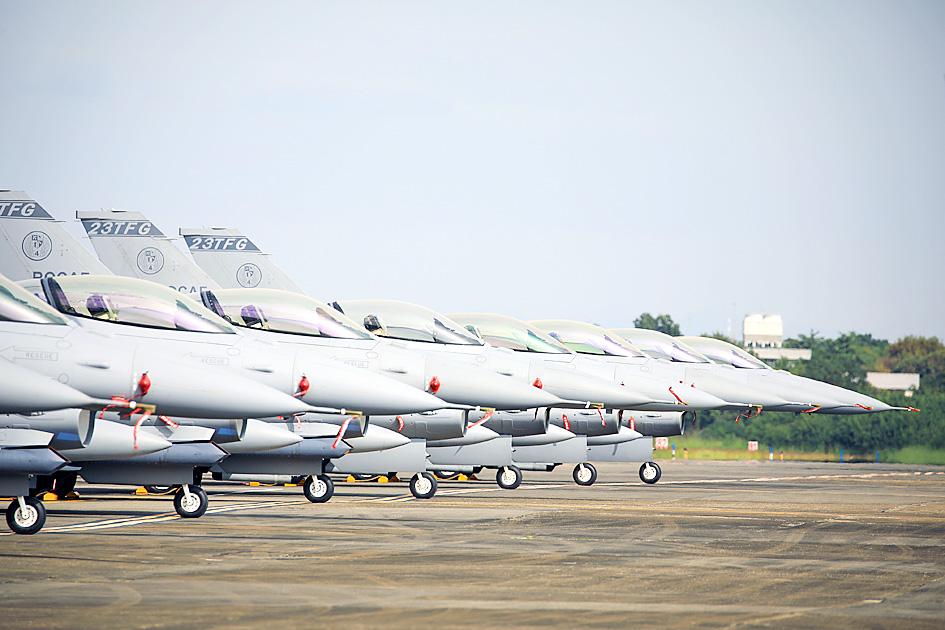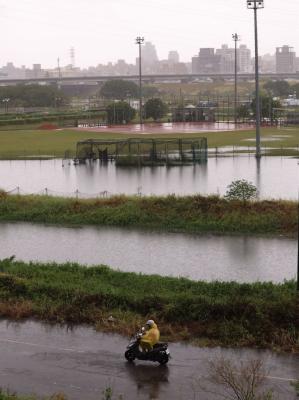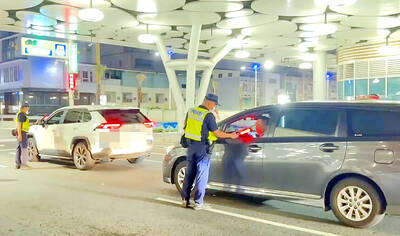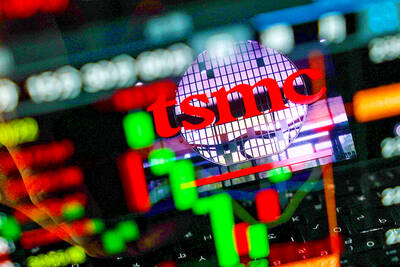Without completed infrastructure and training, the expedited sale of new F-16s from the US could become a burden rather than a help, a military official said yesterday.
Reuters on Thursday last week reported that Washington is looking to accelerate the delivery of 66 new F-16C/D Block 70 aircraft in response to what it sees as increasing intimidation by Beijing.
Under the terms of the original US$8 billion deal signed in 2019, the US is expected to deliver a single-seater and double-seater for testing next year, then deliver the 66 new aircraft in batches of four or five from 2024 to 2026.

Photo: Bloomberg
The officials cited by Reuters had not yet figured out how to expedite the delivery, which would likely delay deliveries to other US partners facing threats from Iran and Russia.
However, a military official yesterday played down the significance of the move, as it would still take time to build out the necessary infrastructure and train personnel.
In particular, facilities at Chihhang Air Base in Taitung County where the jets would be stationed are still under construction, the former air force general said on condition of anonymity.
Rather than acquiring new aircraft earlier than planned, it would be better to accelerate upgrades of older F-16A/B aircraft, as well as radar systems for Mirage 2000s and Indigenous Defense Fighter jets, as it would be more useful against the Chinese threat, the military official said.
Apart from construction, pilots and support personnel are still being trained, retired air force lieutenant general Chang Yan-ting (張延廷) said, adding that accepting deliveries too early would be like “changing your clothes while wearing them.”
The Block 70 might use the same radar system as the F-16A/B Block 20, but since the engines are not the same, it would force trainees and ground mechanics to “burn the candle at both ends,” learning multiple systems at once, he added.
It would be good to receive the planes as fast as possible, as the US air force is quickly replacing its F-16s, but the key to countering hostile threats is to keep personnel, logistics and infrastructure ahead of the curve, Chang said.
Institute for National Defense and Security Research senior analyst Su Tzu-yun (蘇紫雲) was more upbeat on the accelerated schedule, saying that early delivery would allow pilots to familiarize themselves with the newest aircraft along with the newly upgraded F-16A/Bs.

Taipei, New Taipei City, Keelung and Taoyuan would issue a decision at 8pm on whether to cancel work and school tomorrow due to forecasted heavy rain, Keelung Mayor Hsieh Kuo-liang (謝國樑) said today. Hsieh told reporters that absent some pressing reason, the four northern cities would announce the decision jointly at 8pm. Keelung is expected to receive between 300mm and 490mm of rain in the period from 2pm today through 2pm tomorrow, Central Weather Administration data showed. Keelung City Government regulations stipulate that school and work can be canceled if rain totals in mountainous or low-elevation areas are forecast to exceed 350mm in

TRAFFIC SAFETY RULES: A positive result in a drug test would result in a two-year license suspension for the driver and vehicle, and a fine of up to NT$180,000 The Ministry of Transportation and Communications is to authorize police to conduct roadside saliva tests by the end of the year to deter people from driving while under the influence of narcotics, it said yesterday. The ministry last month unveiled a draft of amended regulations governing traffic safety rules and penalties, which included provisions empowering police to conduct mandatory saliva tests on drivers. While currently rules authorize police to use oral fluid testing kits for signs of drug use, they do not establish penalties for noncompliance or operating procedures for officers to follow, the ministry said. The proposed changes to the regulations require

EVA Airways president Sun Chia-ming (孫嘉明) and other senior executives yesterday bowed in apology over the death of a flight attendant, saying the company has begun improving its health-reporting, review and work coordination mechanisms. “We promise to handle this matter with the utmost responsibility to ensure safer and healthier working conditions for all EVA Air employees,” Sun said. The flight attendant, a woman surnamed Sun (孫), died on Friday last week of undisclosed causes shortly after returning from a work assignment in Milan, Italy, the airline said. Chinese-language media reported that the woman fell ill working on a Taipei-to-Milan flight on Sept. 22

1.4nm WAFERS: While TSMC is gearing up to expand its overseas production, it would also continue to invest in Taiwan, company chairman and CEO C.C. Wei said Taiwan Semiconductor Manufacturing Co (TSMC) has applied for permission to construct a new plant in the Central Taiwan Science Park (中部科學園區), which it would use for the production of new high-speed wafers, the National Science and Technology Council said yesterday. The council, which supervises three major science parks in Taiwan, confirmed that the Central Taiwan Science Park Bureau had received an application on Friday from TSMC, the world’s largest contract chipmaker, to commence work on the new A14 fab. A14 technology, a 1.4 nanometer (nm) process, is designed to drive artificial intelligence transformation by enabling faster computing and greater power